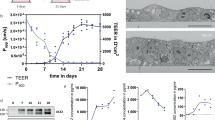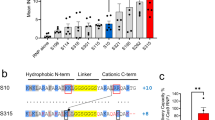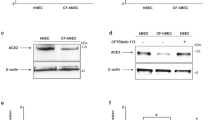Abstract
Differences between rodent and human airway cell biology have made it difficult to translate recombinant adeno-associated virus (rAAV)-mediated gene therapies to the lung for cystic fibrosis (CF). As new ferret and pig models for CF become available, knowledge about host cell/vector interactions in these species will become increasingly important for testing potential gene therapies. To this end, we have compared the transduction biology of three rAAV serotypes (AAV1, 2 and 5) in human, ferret, pig and mouse-polarized airway epithelia. Our results indicate that apical transduction of ferret and pig airway epithelia with these rAAV serotypes closely mirrors that observed in human epithelia (rAAV1>rAAV2≅rAAV5), while transduction of mouse epithelia was significantly different (rAAV1>rAAV5≫rAAV2). Similarly, ferret, pig and human epithelia also shared serotype-specific differences in the polarity (apical vs basolateral) and proteasome dependence of rAAV transduction. Despite these parallels, N-linked sialic acid receptors were required for rAAV1 and rAAV5 transduction of human and mouse airway epithelia, but not ferret or pig airway epithelia. Hence, although the airway tropisms of rAAV serotypes 1, 2 and 5 are conserved better among ferret, pig and human as compared to mouse, viral receptors/co-receptors appear to maintain considerable species diversity.
This is a preview of subscription content, access via your institution
Access options
Subscribe to this journal
Receive 12 print issues and online access
$259.00 per year
only $21.58 per issue
Buy this article
- Purchase on Springer Link
- Instant access to full article PDF
Prices may be subject to local taxes which are calculated during checkout



Similar content being viewed by others
References
Zhang LN, Karp P, Gerard CJ, Pastor E, Laux D, Munson K et al. Dual therapeutic utility of proteasome modulating agents for pharmaco-gene therapy of the cystic fibrosis airway. Mol Ther 2004; 10: 990–1002.
Sirninger J, Muller C, Braag S, Tang Q, Yue H, Detrisac C et al. Functional characterization of a recombinant adeno-associated virus 5-pseudotyped cystic fibrosis transmembrane conductance regulator vector. Hum Gene Ther 2004; 15: 832–841.
Liu X, Luo M, Zhang LN, Yan Z, Zak R, Ding W et al. Spliceosome-mediated RNA trans-splicing with recombinant adeno-associated virus partially restores cystic fibrosis transmembrane conductance regulator function to polarized human cystic fibrosis airway epithelial cells. Hum Gene Ther 2005; 16: 1116–1123.
Afione SA, Conrad CK, Kearns WG, Chunduru S, Adams R, Reynolds TC et al. In vivo model of adeno-associated virus vector persistence and rescue. J Virol 1996; 70: 3235–3241.
Conrad CK, Allen SS, Afione SA, Reynolds TC, Beck SE, Fee-Maki M et al. Safety of single-dose administration of an adeno-associated virus (AAV)-CFTR vector in the primate lung. Gene Therapy 1996; 3: 658–668.
Moss RB, Rodman D, Spencer LT, Aitken ML, Zeitlin PL, Waltz D et al. Repeated adeno-associated virus serotype 2 aerosol-mediated cystic fibrosis transmembrane regulator gene transfer to the lungs of patients with cystic fibrosis: a multicenter, double-blind, placebo-controlled trial. Chest 2004; 125: 509–521.
Flotte TR, Zeitlin PL, Reynolds TC, Heald AE, Pedersen P, Beck S et al. Phase I trial of intranasal and endobronchial administration of a recombinant adeno-associated virus serotype 2 (rAAV2)-CFTR vector in adult cystic fibrosis patients: a two-part clinical study. Hum Gene Ther 2003; 14: 1079–1088.
Liu X, Luo M, Trygg C, Yan Z, Lei-Butters DC, Smith CB et al. Biological differences in rAAV transduction of human and Old World non-human primate airway epithelia. Mol Ther 2007; doi:10.1038/sj.mt.6300277 (in press).
Grubb BR, Boucher RC . Pathophysiology of gene-targeted mouse models for cystic fibrosis. Physiol Rev 1999; 79: S193–S214.
Scholte BJ, Davidson DJ, Wilke M, De Jonge HR . Animal models of cystic fibrosis. J Cyst Fibros 2004; 3 (Suppl 2): 183–190.
Liu X, Yan Z, Luo M, Engelhardt JF . Species-specific differences in mouse and human airway epithelial biology of recombinant adeno-associated virus transduction. Am J Respir Cell Mol Biol 2006; 34: 56–64.
Rogers C, Hao Y, Rokhlina T, Yan Z, Engelhardt J, Prather R et al. Gene targeting of pig CFTR: progress toward a large animal model of cystic fibrosis. Pediatr Pulmonol 2006 (Suppl 29): 281.
Li Z, Engelhardt JF . Progress toward generating a ferret model of cystic fibrosis by somatic cell nuclear transfer. Reprod Biol Endocrinol 2003; 1: 83.
Li Z, Sun X, Chen J, Liu X, Wisely SM, Zhou Q et al. Cloned ferrets produced by somatic cell nuclear transfer. Dev Biol 2006; 293: 439–448.
Jeffery PK . Morphologic features of airway surface epithelial cells and glands. Am Rev Respir Dis 1983; 128: S14–S20.
Leigh MW, Gambling TM, Carson JL, Collier AM, Wood RE, Boat TF . Postnatal development of tracheal surface epithelium and submucosal glands in the ferret. Exp Lung Res 1986; 10: 153–169.
Wang X, Zhang Y, Amberson A, Engelhardt JF . New models of the tracheal airway define the glandular contribution to airway surface fluid and electrolyte composition. Am J Respir Cell Mol Biol 2001; 24: 195–202.
Pavelka M, Ronge HR, Stockinger G . [Comparative study of tracheal epithelium of different mammals]. Acta Anat (Basel) 1976; 94: 262–282.
Karp PH, Moninger TO, Weber SP, Nesselhauf TS, Launspach JL, Zabner J et al. An in vitro model of differentiated human airway epithelia. Methods for establishing primary cultures. Methods Mol Biol 2002; 188: 115–137.
Davidson DJ, Kilanowski FM, Randell SH, Sheppard DN, Dorin JR . A primary culture model of differentiated murine tracheal epithelium. Am J Physiol Lung Cell Mol Physiol 2000; 279: L766–L778.
Liu X, Luo M, Zhang L, Ding W, Yan Z, Engelhardt JF . Bioelectric properties of chloride channels in human, pig, ferret, and mouse airway epithelia. Am J Respir Cell Mol Biol 2007; 36: 313–323.
Yan Z, Lei-Butters DC, Liu X, Zhang Y, Zhang L, Luo M et al. Unique biologic properties of recombinant AAV1 transduction in polarized human airway epithelia. J Biol Chem 2006; 281: 29684–29692.
Yan Z, Zak R, Luxton GW, Ritchie TC, Bantel-Schaal U, Engelhardt JF . Ubiquitination of both adeno-associated virus type 2 and 5 capsid proteins affects the transduction efficiency of recombinant vectors. J Virol 2002; 76: 2043–2053.
Duan D, Yue Y, Yan Z, Yang J, Engelhardt JF . Endosomal processing limits gene transfer to polarized airway epithelia by adeno-associated virus. J Clin Invest 2000; 105: 1573–1587.
Walters RW, Yi SM, Keshavjee S, Brown KE, Welsh MJ, Chiorini JA et al. Binding of adeno-associated virus type 5 to 2,3-linked sialic acid is required for gene transfer. J Biol Chem 2001; 276: 20610–20616.
Summerford C, Samulski RJ . Membrane-associated heparan sulfate proteoglycan is a receptor for adeno-associated virus type 2 virions. J Virol 1998; 72: 1438–1445.
Duan D, Yue Y, Engelhardt JF . Response to ‘polarity influences the efficiency of recombinant adeno-associated virus infection in differentiated airway epithelia’. Hum Gene Ther 1999; 10: 1553–1557.
Wu Z, Miller E, Agbandje-McKenna M, Samulski RJ . Alpha2,3 and alpha2,6 N-linked sialic acids facilitate efficient binding and transduction by adeno-associated virus types 1 and 6. J Virol 2006; 80: 9093–9103.
Seiler MP, Miller AD, Zabner J, Halbert CL . Adeno-associated virus types 5 and 6 use distinct receptors for cell entry. Hum Gene Ther 2006; 17: 10–19.
Walters RW, Pilewski JM, Chiorini JA, Zabner J . Secreted and transmembrane mucins inhibit gene transfer with AAV4 more efficiently than AAV5. J Biol Chem 2002; 277: 23709–23713.
Liu X, Yan Z, Luo M, Zak R, Li Z, Driskell RR et al. Targeted correction of single-base-pair mutations with adeno-associated virus vectors under nonselective conditions. J Virol 2004; 78: 4165–4175.
Ding W, Zhang LN, Yeaman C, Engelhardt JF . rAAV2 traffics through both the late and the recycling endosomes in a dose-dependent fashion. Mol Ther 2006; 13: 671–682.
Acknowledgements
This work was supported by NIH RO1 HL58340 (JFE), the Center for Gene Therapy (DK54759) and Targeted Genetics Corporation. We also gratefully acknowledge the Roy J Carver Chair in Molecular Medicine (JFE) and Dr Christine Blaumueller for editorial assistance.
Author information
Authors and Affiliations
Corresponding author
Rights and permissions
About this article
Cite this article
Liu, X., Luo, M., Guo, C. et al. Comparative biology of rAAV transduction in ferret, pig and human airway epithelia. Gene Ther 14, 1543–1548 (2007). https://doi.org/10.1038/sj.gt.3303014
Received:
Accepted:
Published:
Issue Date:
DOI: https://doi.org/10.1038/sj.gt.3303014
Keywords
This article is cited by
-
Tissue and cell-type-specific transduction using rAAV vectors in lung diseases
Journal of Molecular Medicine (2021)
-
Testing gene therapy vectors in human primary nasal epithelial cultures
Molecular Therapy - Methods & Clinical Development (2015)
-
Influenza A penetrates host mucus by cleaving sialic acids with neuraminidase
Virology Journal (2013)
-
Distinct transduction difference between adeno-associated virus type 1 and type 6 vectors in human polarized airway epithelia
Gene Therapy (2013)
-
A Novel Chimeric Adenoassociated Virus 2/Human Bocavirus 1 Parvovirus Vector Efficiently Transduces Human Airway Epithelia
Molecular Therapy (2013)



